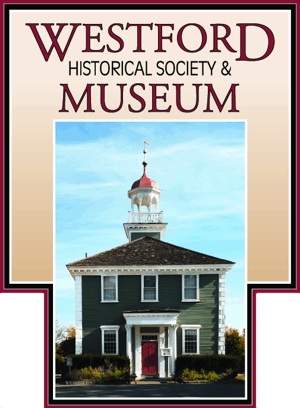The First Half-Century of the Historical Society and Museum: Briefly!
Founded to study Westford history, stimulate the collection and preservation of related manuscripts and artifacts, and encourage research and dissemination of historical information, the Westford Historical Society held its first meeting on November 20, 1958. This initiative was inspired and led by Allister MacDougall. The initial group consisted of about 35 members, primarily long-time residents, who gathered at the Fletcher Library. Typically, each attendee shared a historical item and brought “delicious hot soup,” as noted in the minutes. One had to apply, be voted in, and pay a dollar to join.
Five years later, the Society was incorporated under Chapter 30, Section 3 of the Massachusetts General Laws, with Walter Fletcher as chairman to accept the property legally. By then, they had already acquired the famous “Boat Stone.” They spent considerable time discussing the “Burial Stone of a Scottish Knight,” which would become a recurring topic in the Society’s discussions over the next fifty years.
By 1965, the Society had mainly become inactive, but it regained momentum in 1968 by holding the First Annual Antique Sale on the Common. Due to the remodeling of the library, the group relocated to the Tadmuck Club while noting that the original Academy building would make an ideal headquarters when it was no longer needed as a fire station.
In 1974, a $7,000 Bicentennial Grant from the state facilitated the restoration of the former Academy building, even before it was officially transferred to the Historical Commission, created by Town Meeting in 1975. The Rotary Club and over 200 families and businesses contributed to restoring the Academy building, which was dedicated as a Historical Museum in 1976. Beth Shaw and David Watson formed the Friends of the Museum. Over the years, many individuals, including Lloyd Blanchard, Gordon Seavey, John Crisafulli, Alex Belida, and at least 100 others, initiated and continued the project.
During this time, the Museum Board and the Historical Society functioned as separate entities with shared interests. They established policies for acquiring donations ranging from dolls to antique fire trucks while managing issues such as frozen pipes and lightning strikes to the cupola. After an initial surge of excitement and support, both organizations struggled with a lack of volunteers and funds. In 1988, they acquired the dispatcher’s cottage next to the Museum, receiving a warning not to place heavy file cabinets in the aging structure’s center.
In earlier years, meetings were often held jointly in the mornings, although the Society sometimes met only twice yearly. Meanwhile, the Museum Board faced challenges in purchasing and learning to use a computer for tracking accessions. Programs were organized on various topics, including the history of toys, farms, trains, and even the Big Dig. In 1990, the Junior Women’s Club began hosting third-grade tours of Westford and its Museum, emphasizing a tradition of collaboration with students at every educational level. As a repository of primary sources, the Museum attracts researchers nationwide. A graduate student from the University of Lowell, who started as an intern at the Museum, became one of its first paid part-time curators.
Over the years, suggestions have been made to merge the Museum Board and the Historical Society officially. In the 1990s, the Society’s assets were transferred to the Museum Board but kept in separate accounts to maintain its tax-exempt status. The administrative structure was then officially renamed “The Westford Historical Society and Museum,” eventually becoming “The Westford Historical Society, Inc.” The Westford Historic Commission retains care and custody of the buildings and receives a budget from the town for maintenance and utilities.
The Historical Society has been influenced over the years by rapid population growth. It changes in Westford, which is facing challenges in attracting younger working couples who have moved into the area without knowledge of local history. 1998, a successful folk concert series was launched to draw people into the Museum. President Ken Tebbetts, Acquisition Chair Lizette Greaves, and Treasurer Mike Harde gathered support and funds for the 1999 Parish Hall next-door acquisition, now leased to the Parish Center for the Arts. The Museum continues to host recurring favorites such as the Barn and Attic Sale, Skinner Auction House Appraisal Day, genealogy classes, St. Distaff’s Day, a Holiday Celebration for town employees, and two re-publications of Hodgeman’s History of Westford, along with February book discussions. Speakers and special exhibits led by long-time directors, including Marilyn Day, have also helped to attract visitors.
Society has embraced a modern spirit in the twenty-first century, exemplified by Andy Norander and Jim Bogue’s founding of the Westford Academy Museum Club. The Society has even acquired several historical Westford artifacts discovered on eBay, showcasing its ongoing dedication to preserving local history.
